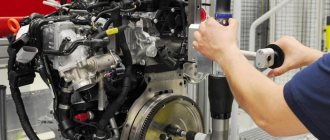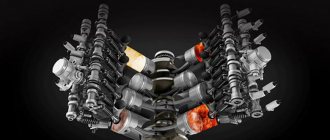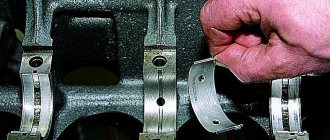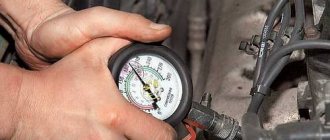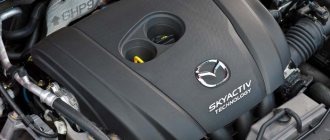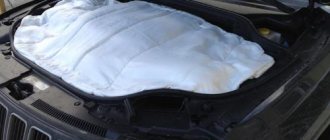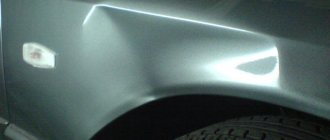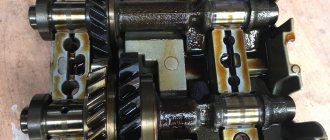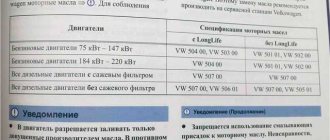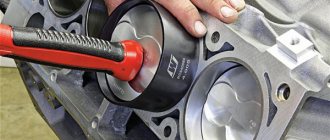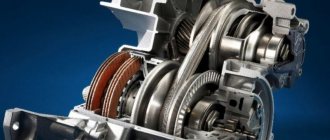A huge amount of fuel passes through the engine during its operation. Unburnt fuel, oil from the cylinder walls, and other impurities form hydrocarbon deposits, that is, carbon deposits, on the piston rings.
Soot is a product formed as a result of combustion and coking of motor oil and semi-solids, soft impurities contained in fuel. To prevent wear of the cylinder-piston assembly and normalize engine operation, the motor requires periodic cleaning of carbon deposits and deposits.
Carbon deposits can be deposited on many engine components, such as:
- Intake and exhaust manifold;
- Engine valves;
- Valve seats;
- EGR valve;
- Turbocharger;
- Swirl flaps;
- Rings and pistons;
- Particulate filter and catalyst and so on.
The main reason for the formation of deposits in modern engines is considered to be impurities in the fuel, which mix and interact with the engine oil. The formation of carbon deposits is also facilitated by so-called refiners added to the fuel. Their main purpose is to reduce the likelihood of detonation combustion of fuel.
In addition, the following factors also influence the rapid accumulation of carbon:
- Driving in a cold car.
- Traveling short distances.
- The so-called economical driving style, that is, the deliberate avoidance of medium and high engine speeds.
Over time, due to high temperatures, deposits harden and coke, compression drops, fuel and oil consumption increases, and the piston group wears out. The question invariably arises about methods for decoking an engine, what is the best way to do this procedure, and how to prevent such a problem in the future? In this article we will answer all these questions.
It should be noted in advance that you should not expect a miracle from the decarbonization process. This is especially true in cases where the engine is already quite worn out (the car's mileage is more than 200,000 km). First of all, engine decarbonization is prevention, not resuscitation of the car. But as part of regular maintenance, cleaning the engine from carbon deposits can help rid the engine of many problems and malfunctions, for example:
- The engine tweaks and jerks;
- High oil and (or) fuel consumption;
- Difficulty starting the engine;
- Reduced compression in one or more cylinders;
- The car smokes a lot: the smoke is blue, black;
- The engine often overheats and boils;
- Reduced engine power.
With the availability of modern means, engine decarbonization is not a complicated procedure and is quite accessible to do it yourself. When a car is more alive than dead, decarbonizing the piston rings will definitely benefit it.
Methods for decarbonizing piston rings without disassembling the engine
Experienced car enthusiasts and mechanics know several ways to decarbonize piston rings without disassembling the engine. We'll tell you more about each of them below.
A hard way to decarbonize a power unit
This decarbonization method involves pouring special agents directly into the cylinder. This is the most complex process, let's look at it in more detail:
- Give the vehicle a strictly horizontal orientation.
- Start the engine and warm it up to normal operating condition.
- Remove spark plugs or injectors.
- Center the piston by rotating the crankshaft.
- Fill in the amount specified in the cylinder instructions and plug the spark plug holes.
- Disable the ignition system in any way.
- Over the course of an hour, periodically rotate the crankshaft in a range of 10 degrees to move the pistons. Although the option is practiced without moving the crankshaft. In this case, exposure is carried out for 12 hours (depending on the product used). The volume of infused auto chemicals is also increasing.
- Remove the plugs from the spark plug wells. Depress the accelerator pedal fully. Using the starter, try turning the shaft several times for 10 seconds.
- Reinstall the parts in the correct order.
- Start the engine. Drive it for about ten minutes at idle speed, adding a little gas from time to time. Do not exceed engine speed more than 60% of maximum.
- Change the oil and filter.
Before starting work, you should remember that all chemicals are quite toxic, so engine decarbonization should be carried out only in fresh air.
A gentle method for decoking piston rings
Essentially, it is a chemical additive to motor oil or automobile fuel. After filling, the car will need to drive a certain distance, after which some of the carbon deposits will be removed from the piston rings.
This is the best way for novice drivers and those who do not have the necessary experience or time to completely decarbonize the power unit. Let's look at these two methods in more detail.
Pouring into oil
Before you start changing the engine oil, you should pour a special chemical into it. This product can be purchased at any store specializing in the sale of automobile parts. To remove carbon deposits from rings with such a mixture, you need to drive about 200 kilometers. This is followed by a mandatory oil and oil filter change. At this point, the decarbonization procedure can be considered complete.
When using this method, you should remember that after adding cleaning additives, the oil will become more liquid, so high engine speeds when driving in this case are not permissible. Also, this method is not suitable for completely cleaning the piston system.
Fuel additive
In this case, a special cleaning agent is poured into the tank. Mixed with fuel, the product gradually dissolves deposits into small particles, which then burn out and exit with gases through the exhaust pipe. The advantages of this cleaning method are obvious:
- There is no need to leave the car idle for a long time;
- There is no need to disassemble the power unit;
- High engine speeds with this method will only speed up the decarbonization process;
- There is also no need to change the oil after completing this procedure, since the decoking agent does not get into the oil.
This decoking method is the simplest, however, and the longest. It is recommended to use it only for preventive purposes.
How and why does the so-called “coke” deposition occur?
Important: The main “supplier” of the problem is engine oil.
Let's immediately dispel some misconceptions. For some reason, it is generally accepted that slag deposits are possible only on old cars, and they are inherited.
Indeed, modern diesel fuel is cleaner (we reject unscrupulous gas stations, since this is not a systemic problem).
And synthetic oil does not contain a hydrocarbon base, which tends to separate from the composition and stick to the walls of mechanisms. However, the problem of hard deposits is equally inherent in modern power plants.
Causes of coke formation
- technology has become more precise: there are microscopic gaps between the parts of modern mechanisms that are easily clogged;
- engine operation (even diesel) is associated with high temperatures: an ideal environment for precipitation to stick;
Oil deposits on the shaft journals and housing
- the intensity of work has increased: the lubricant is susceptible to separation, individual fractions easily become slag.
In diesel engines, the situation is aggravated by the presence of soot. This is a unique substance: it can be as small as desired, but the dry component does not dissolve in liquid.
When the piston system operates, soot particles enter the ring gaps and are retained in the cavities. Then heated oil gets there, which evaporates on the hot surface of the piston (we note right away that this is possible if the oil scraper rings lose their tightness).
A mixture of hot grease with solid soot particles is the strongest cement. It instantly deposits on the metal and forms a layer of real varnish.
Carbon deposits on the piston and rings
Of course, in this state the rings do not work. Compression and traction disappear, fuel consumption increases. And the saddest thing is that the problem of coking is growing exponentially. Loaded oil scraper rings allow more and more oil into the hot zone, and the slag layer increases.
The same picture is observed in the timing system. Valves (especially exhaust valves) also operate under intense temperature conditions. If there is motor oil in the cylinders (and we know that it gets there when the rings become coked), then again, together with the soot of the exhaust gases, a dense mass is formed, which over time turns into stone.
Coked engine valves
Another problem that requires diesel decarbonization is incomplete combustion of fuel. During operation, light fractions evaporate and burn, and heavy sediment concentrates in the cavities. Mixing with soot and oil, these compounds again form a layer of slag, which becomes more and more monolithic over time.
Consequences of soot
- Violation of the tightness of the piston rings, valve mechanism;
- The so-called “bedding” of moving elements;
- Reducing the volume of the combustion chamber: hence the loss of power;
- Carbon deposits on the upper arch of the cylinder can lead to untimely ignition of the fuel;
- The biggest problem is the malfunction of the lubrication system.
We recommend: What kind of motor oil should you pour into your engine: synthetic or semi-synthetic?
More about this:
The flow area of the oil channels is reduced: the consequences require no comment. Vibrations may cause small pieces of slag to fall off the walls. These elements can clog the same oil lines and damage various sensors.
How to prevent rings from sticking in the engine?
Systematic engine prevention is based on the use of special liquids that are poured into the fuel tank or engine oil. They are one of the simplest ways to clean the engine from carbon deposits, which “treat” the engine while it is running. Absolutely any driver can carry out this procedure independently.
But, as practice shows, after getting rid of the problem, after a certain time, carbon deposits will appear again, thereby disrupting the operation of the engine systems. The problem may lie in malfunctions of the motor itself, or in violations during its operation and maintenance. In any case, try to adhere to the following recommendations, which will help you avoid many engine problems in the future:
- Change engine oil promptly;
- Avoid prolonged downtime of the machine;
- Warm up the engine at low temperatures for as long as possible;
- Do not keep the car engine idling for a long time;
- Try to put load on the engine as little as possible at low engine speeds;
- Periodically use anti-carbon additives;
- Fill only with high-quality fuel at proven gas stations.
Carbon formation zones
Coke deposits accumulate in the grooves located under the compression and oil scraper rings. This leads to insufficiently tight fit of the rings to the cylinder walls and poor quality oil removal. Continued use of oil scraper rings without repair leads to friction, overheating of parts and burnouts in the piston.
Signs of ring wear:
- Oil on exhaust pipe;
- A sharp increase in oil consumption;
- Blue smoke from the chimney when starting to move;
- Dirty spark plugs.
Analyze whether your car has one or more signs and, having given a positive answer, check the functionality of the oil scraper rings.
Decarbonizing the engine, what is the best way to do it?
Modern scientific developments compete with each other, providing ample opportunities for the consumer. Each of the chemicals has its own characteristics and features, both in composition and in price and method of use.
Each product has detailed instructions for use, so we will simply look at the brief characteristics of the most popular of them:
- "Xado Anti-Coke" gives the best results in all stated parameters, but has a high cost.
- "SURM" is a Russian-made product. Shows excellent efficiency and does not require changing the engine oil.
- “Vince” – cleans the intake manifold, ring grooves, regulates compression, valve mobility and removes vibration. Requires the use of special tools. Shows good results if you strictly follow the instructions.
- “Liqui Moly OiI-Schlamm-Spulung” is in practice an effective additive for the lubrication system. However, its effectiveness as a cleaner has not been confirmed in testing.
- "Lavr ML-202" is a domestic product, one of the popular cleaning products. A good option that gives good results at a low cost. It is used, like Hado, also for prevention. Normalizes compression, cleans grooves and rings. Cleans the walls of combustion chambers. Penetrating into the cylinder, the product is converted into steam and destroys deposits in 60 minutes.
Decoking of piston rings using the old-fashioned method
The most famous old composition includes kerosene, motor oil and acetone. This mixture is mixed in the following ratio:
- 40% acetone;
- 40% kerosene;
- 20% motor oil.
The finished “thermonuclear” chemistry is poured into each cylinder for 10-12 hours, which removes absolutely all deposits. There is undoubtedly a negative effect on the motor, but it has not yet been widely studied, since most tests give a positive effect. Fill at the rate of 50 ml per cylinder.
Let's sum it up
Decarbonization will not help with high wear of parts; in this case, engine performance may even worsen. However, in a less dire situation, the service life of the engine will only increase. When you need to clean your engine from carbon deposits, choose the methods that are most convenient for you and that best suit your parameters.
Now you know enough ways to decarbonize an engine, what is the best way to do such a procedure, and how to generally avoid problems with carbon deposits. We hope you found this material useful. Don’t forget about periodic preventative maintenance and don’t be afraid to repair your car yourself.
New articles
- Is it possible to mix antifreeze of different colors, brands and classes? - Let's figure it out
- How to check and increase the density of electrolyte in a battery at home?
